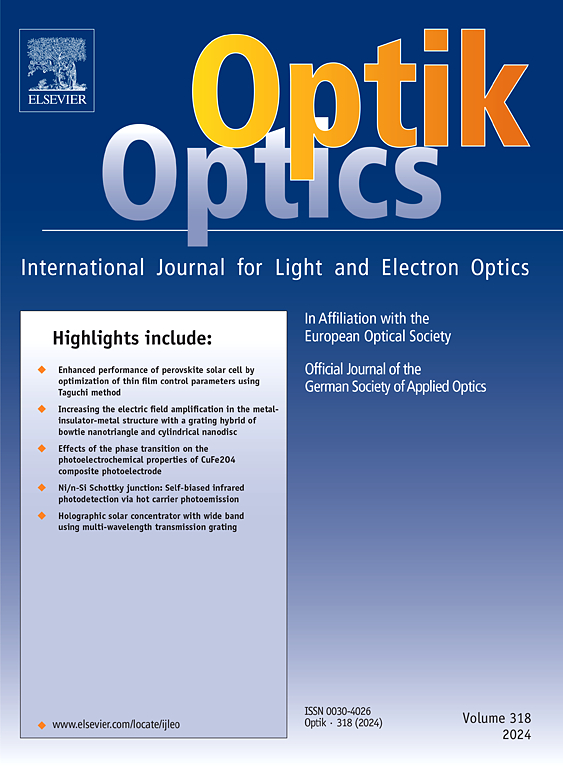Design and fabrication of the high-precision beam splitter with stress compensation analysis for infrared band-pass filters
IF 3.1
3区 物理与天体物理
Q2 Engineering
引用次数: 0
Abstract
This paper uses thin film interference principles to introduce a stress-compensated beam splitter design for infrared band-pass filters. The beam splitter provides high transmittance (96%) at 1540.53 nm while maintaining high reflectance (99.5%) at 1563 nm. The fabrication process utilizes an electron beam ion-assisted deposition technology. Tantalum pentoxide (Ta2O5) and silicon dioxide (SiO2) are chosen for their respective high and low refractive indices, forming the basis of the design. However, a significant challenge in fabrication lies in managing the root mean square (RMS) value of wavefront error induced by high packing density during electron beam ion-assisted deposition process. To address this, in this work, we developed a stress model to analyze the overall stress within the multilayer Ta2O5/SiO2 structure because the fluctuation in stress exerted on the substrate affects the RMS value of wavefront error. From the stress model analysis, we employ backside coating which emerges as a viable solution to mitigate stress, ensuring structural integrity. The backside coating, chosen through a stress model, decreases the compressive stress from −46.94 MPa to −1.88 MPa and also reduces the RMS wavefront error from 63.60 nm to 8.26 nm. After stress compensation, the beam splitter’s transmission properties are evaluated using a spectrophotometer. The experimental results validate the performance of the fabricated beam splitter, meeting the specifications outlined in the study.
红外带通滤波器高精度分束器的设计与制造
本文利用薄膜干涉原理,介绍了一种用于红外带通滤波器的应力补偿分束器设计。分束器在1540.53 nm处提供高透射率(>96%),同时在1563 nm处保持高反射率(>99.5%)。制造过程采用电子束离子辅助沉积技术。五氧化二钽(Ta2O5)和二氧化硅(SiO2)的高折射率和低折射率是设计的基础。然而,电子束离子辅助沉积过程中高堆积密度引起的波前误差的均方根(RMS)值的控制是电子束离子辅助沉积过程中面临的一个重大挑战。为了解决这个问题,在这项工作中,我们开发了一个应力模型来分析多层Ta2O5/SiO2结构内部的整体应力,因为施加在衬底上的应力波动会影响波前误差的均方根值。从应力模型分析中,我们采用背面涂层作为缓解应力的可行解决方案,确保结构的完整性。通过应力模型选择涂层后,压缩应力从- 46.94 MPa降至- 1.88 MPa,波前误差从63.60 nm降至8.26 nm。在应力补偿后,用分光光度计对分束器的透射特性进行了评价。实验结果验证了该分束器的性能,达到了研究中提出的要求。
本文章由计算机程序翻译,如有差异,请以英文原文为准。
求助全文
约1分钟内获得全文
求助全文
来源期刊

Optik
物理-光学
CiteScore
6.90
自引率
12.90%
发文量
1471
审稿时长
46 days
期刊介绍:
Optik publishes articles on all subjects related to light and electron optics and offers a survey on the state of research and technical development within the following fields:
Optics:
-Optics design, geometrical and beam optics, wave optics-
Optical and micro-optical components, diffractive optics, devices and systems-
Photoelectric and optoelectronic devices-
Optical properties of materials, nonlinear optics, wave propagation and transmission in homogeneous and inhomogeneous materials-
Information optics, image formation and processing, holographic techniques, microscopes and spectrometer techniques, and image analysis-
Optical testing and measuring techniques-
Optical communication and computing-
Physiological optics-
As well as other related topics.
 求助内容:
求助内容: 应助结果提醒方式:
应助结果提醒方式:


